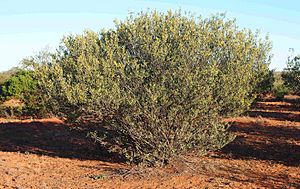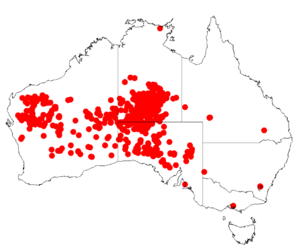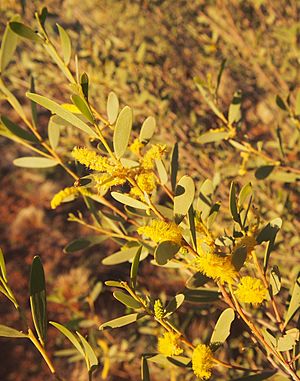Wanderrie wattle facts for kids
Quick facts for kids Wanderrie wattle |
|
|---|---|
 |
|
| Scientific classification | |
| Genus: |
Acacia
|
| Species: |
kempeana
|
 |
|
| Occurrence data from AVH | |
The Wanderrie Wattle, also known as the Witchetty Bush or Granite Wattle, is a special type of plant. Its scientific name is Acacia kempeana. The name Acacia comes from a Greek word meaning "thorn." The "kempeana" part honors Pastor Kempe, who helped start a mission in Australia in 1877.
This plant is a shrub or small tree. It belongs to the Fabaceae family, which includes peas and beans. The Wanderrie Wattle is found only in the dry, central, and western parts of Australia. This means it is an endemic species there.
Contents
What Does the Wanderrie Wattle Look Like?
The Wanderrie Wattle usually grows as a spreading bush or a small tree. It often has many stems. It can reach a height of 1 to 6 meters (about 3 to 20 feet). Some can even grow taller than 10 meters (over 30 feet)!
Bark and Branches
The bark of this plant is usually grey or brown. It has deep grooves, like wrinkles. Its small branches are smooth and round. They might look a bit dusty.
Leaves and Flowers
Like many Acacia plants, the Wanderrie Wattle has special "leaves" called phyllodes. These are not true leaves but flattened leaf stalks. They are bright green, grey-green, or blue-green. Each phyllode can be up to 9 cm (about 3.5 inches) long and 1.5 cm (about 0.6 inches) wide. They are usually long and narrow, shaped like an oval.
The flowers are yellow and grow in cylinder-shaped clusters. These clusters are about 1 to 2 cm (0.4 to 0.8 inches) long. You can see the flowers between January or April and September.
Seed Pods
After flowering, the plant produces papery seed pods. These pods are about 7 cm (about 2.7 inches) long and 1.5 cm (about 0.6 inches) wide.
How is the Wanderrie Wattle Used?
The common name "Witchetty Bush" comes from its use by Aboriginal Australian peoples. They find witchetty grubs in the roots of this plant. These grubs are an important food source.
The bush also provides other edible items. Its gum can be eaten. The seeds of the Wanderrie Wattle are also a food source.
Where Does the Wanderrie Wattle Grow?
This shrub is found in many dry and semi-dry areas of Australia. You can see it in:
It often grows on rocky hillsides. It can also be found in different types of soil, especially sandy or loamy soils on plains. It is often part of the mulga woodland communities.
Growing Your Own Wanderrie Wattle
If you want to grow a Wanderrie Wattle, you can start from its seeds. The seeds need to be scratched or soaked in hot water first. This helps them sprout.
This plant grows well in sunny spots. It needs soil that drains water easily. It is a very tough plant. It can handle dry conditions and even frost. It does not need a lot of care once it is established.



